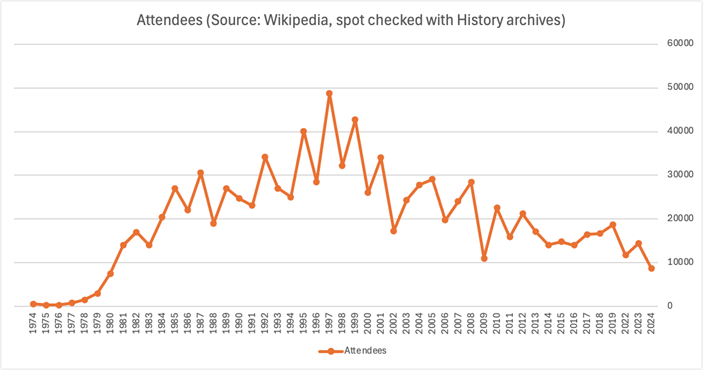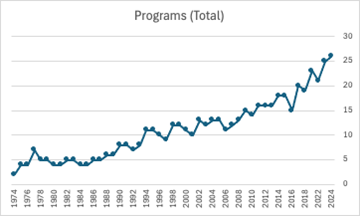Dear ACM SIGGRAPH Community,
It is with immense excitement and a deep sense of responsibility that I embrace the role of Executive Committee (EC) Chair for ACM SIGGRAPH. I am honored to lead this incredible community that I have been an active participant in for almost 30 years until my term as Chair ends 30 August, 2026 when our newly confirmed Chair-Elect, June Kim, will be taking over.
As I step into this position, I want to express my sincere gratitude to our outgoing Chair, Eakta Jain, for her dedicated leadership. I also extend my heartfelt thanks to the Executive Committee members who concluded their service this year, including Mona Kasra, Shimin Hu. and our dedicated Treasurer, Brad Lawrence, for their invaluable contributions to our organization. Their hard work has laid a foundation upon which we will continue to build.
I also recognize that I am entering a situation that requires immediate action to repair broken trust within our community. The Chair’s Corner is focused on a key example of that break in trust: our handling of the dissent by members of our community in the choice of Kuala Lumpur for SIGGRAPH Asia 2026.
In December 2024, the site selection for the SIGGRAPH Asia 2026 conference was brought to the Executive Committee as an urgent matter to be resolved in the meeting. We saw a brief presentation of the options with the recommendation by the SIGGRAPH Asia Conference Advisory Group (SACAG) for Kuala Lumpur as the location. The vote was taken virtually due to time constraints in the EC meeting. This is reflected in our public minutes of that meeting.
From then on, there was limited communication from the EC on the matter. This was because, after learning of the concerns from the community, the EC was divided on how to respond. In hindsight, the choice not to respond at all in the face of a divided team was incorrect.
In the virtual Townhall held on 15 Sept after SIGGRAPH, this issue was discussed, along with a request to “release the May minutes!”. That demand led us to realize that our EC meeting minutes had not been published since May due to a clerical error, which has now been addressed here.
That has led to two other actions:
- Summary of the EC’s deliberations regarding SIGGRAPH Asia. The public minutes do not indicate what we discussed and I have gotten permission from the EC members at that time to publish this overview of what happened “behind closed (virtual) doors”.
- Fulsome, public minutes published. We have ended the practice of public and private minutes and will be publishing detailed discussions under Chatham House Rule. You should see the difference starting with the minutes that have already been published during my term. This practice will also guide our personal conversations as EC members to ensure we can engage freely with our colleagues and the community at large.
However, those efforts toward transparency are not enough. We got into this situation because the decision was rushed and lacked specific guidance on how to make it. With a third of the EC entering each year and an annually rotating Chair, clear programs of necessary activities and decision-making are essential to keep us running efficiently.
To that end, a key focus of my term as Chair is to create a comprehensive project plan, complete with lead times and preparation steps for all major decisions. This plan will be made publicly accessible, outlining the necessary inputs and timelines to ensure thoughtful consideration and avoid hasty actions. This proactive planning is essential to improving our effectiveness and ensuring decisions are not made under undue pressure.
Specifically, guidelines for conference site selection will be created, and details of each selected location with regard to those guidelines shall be made public. There will always be trade-offs made in selecting the sites for our future conferences but awareness of those trade-offs should be a key part of sharing our decision with the community. I would like to finalize these guidelines soon but have not received significant engagement from the community on them. Thus, I am re-sharing the site selection guidelines here with a request to provide comments and suggestions by 31 Oct.
Finally, I want to address our LGBTQ+ community. I want to assure you that we celebrate and value the LGBTQ+ as part of the SIGGRAPH community, and you deserve to participate safely in our events without fear.
In discussions about our selection of Kuala Lumpur for SIGGRAPH Asia 2026, I used the term “feel unsafe” instead of “unsafe” to emphasize that your feelings about a location’s safety are more important than any specific law or advisory. There are travel advisories advising against travel to Malaysia as well as those that state exercising normal caution. What ultimately matters most is your personal sense of safety. There are clear laws that criminalize same-sex relations in Malaysia, while we have reliable reports of thriving LGBTQ+ communities within the country. As such, I don’t think there is a clear line for safe or unsafe, except for how you feel. That is what I meant by adding “feel” to my language, and I apologize for my wording and the harmful impact it had.
Further, I will say that if I were a transgender individual outside of Malaysia, and looking at the evidence, personally, I would not feel safe traveling to the conference. That’s why I am thankful that our community has pulled together to identify alternative ways to participate in this and future SIGGRAPH and SIGGRAPH Asia conferences.
There is a lot more to come, but that is more than enough for a single update. I truly look forward to connecting with everyone more directly and openly. Please feel free to message ec-chair@siggraph.org to reach both me and June Kim, our Chair-Elect, who will take over in less than a year. If you’d prefer to message me directly, darin_grant@siggraph.org also works. I thank those of you who have already reached out and participated in constructive dialogue. Together, we can foster a more transparent, responsive, and trustworthy ACM SIGGRAPH.
Sincerely,
Darin Grant
ACM SIGGRAPH Executive Committee Chair (1 Sept 2025 – 30 August 2026)




